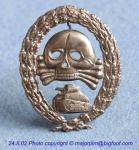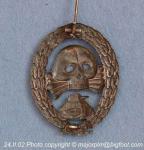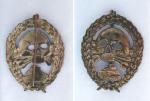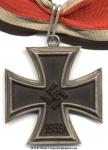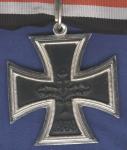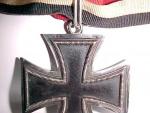-
Posts
2,284 -
Joined
-
Last visited
-
Days Won
6
Content Type
Profiles
Forums
Blogs
Gallery
Events
Store
Everything posted by PKeating
-
Here is a badge that is believed by some to be a 1960s reproduction and by others, usually those who have paid hefty prices for one, to be an original wartime badge made by some German firm for retail sale to recipients. I have always felt the sloppy finishing evident in the haphazard filing of the die flashing to be atypical of prewar and wartime German badge manufacture. Look at the eye sockets. But some people pay high prices for these...although nowhere near as much as for examples that correspond exactly to the type accepted as being from the stock awarded to eligible veterans in the summer of 1939 and through 1940 and 1941. PK
-
This is generally accepted as being a Lisbon-made badge, albeit in bad condition, worn by Heinz-Theo Neumann. The pin is clearly a wartime repair job. But this bears a close resemblance to the badges worn by the officers and NCOs in the photos taken in Spain, which must by definition be the 'in-theatre' badges commissioned by von Thoma from the Lisbon firm.
-
I'd only trust the original Portuguese-made badges - which are ultra-rare - and the German-made type as distributed to members of the Condor Legion's armoured element after their return to Germany in 1939, when the unofficial badge conceived by Ritter von Thoma was accorded official status by OKW and the tankers received certificates and at least one badge each. I accept that Schickle made retail versions of the badge or, at least, planned to and would be prepared to accept that other makers might have included the badge on their lists but the kind of image like the one from the catalogue shown here is simply not detailed enough to be able to tell if a badge that looks like it is, in fact, identical. The same applies to the photo of the reipcient posted by Jacques. We can see that he wears a type of badge seen on the market but a definitive comparison between the badge in the photo and a badge in the hand, so to speak, is simply impossible. Anyone could hold up high end fakes resembling the badges in the catalogue image and the photo and claim them to be the same but they could not prove it beyond reasonable doubt. The Condor Legion Tank Badge has been extensively and convincingly faked since the 1950s. Furthermore, some of the better fakes or repros might be legitimate post-WW2 copies made for veterans, either for retail or to order by the veterans' associations. Unless one of these badges is identical to known originals of the Lisbon or 1939 award pieces, then I am afraid that there will always be a doubt. PK
-
-
Like Bill Garvy, I must confess to never having really registered this aspect of concave and convex oakleaves...and I have been collecting the Iron Cross since I was a nipper! I suppose I must have noticed it but it just didn't register. Thank you for awakening me to something new! There you go! I learned something really valuable today here on GMIC! Just goes to show that there's always something new to learn, doesn't it? Here's an early issue 1870 with one "innie" and two "outies". I haven't scanned any of my other 1870s, except for obverse views but I'm just chucking this one in here because it's from the 1870s. PK
-

EK 1939 S&L RKs -- made in Britain
PKeating replied to George Stimson's topic in Germany: All Eras: The Iron Cross
Ah yes, excuse me, you don't in fact rely on the bin theory at all. My apologies. Quite the contrary in fact. You call is a far-fetched theory. I can see how you arrive at the conclusion that there were two different sets of frame die. It's a reasonable conclusion when one studies the various flaws. I am intrigued, though, by the fact that the dies appear to have been identical. When one studies various parts of the beading, particualarly in the corners, it can be seen that if one die is different from the other, then it's an identical twin, flaws aside. Some pundits would attribute this to the existence of a 'mother die' from which the dies were made but no die-cutter I have ever asked was able to confirm such a method. So what we have is a die-cutter who was able to make, to all intents and purposes, identical copies of what one would call the Type A frame dies. Or perhaps he just made the top die. But he managed to reproduce various aspects of the beading to an astonishing degree of exactness. How about the theory, proposed by some in the past, that the flaws sometimes differ slightly because of the way in which the top die might have been mounted on the press? The die would have been clamped in position, the clamp being secured by high tensile bolts bearing on the reverse of the clamp blocks. If the machinist tooling up the press tightened the bolts manually, without the aid of a torque wrench (and why should he use a torque wrench when the twist of a hand on an 8" wrench (spanner) can exert a ton or more of pressure?), the pressure bearing on the die would have affected the cracks. Do you see what I mean? Let's say that you have a rectangular top die, fitted into the adjustable clamp system on the press, with four clamp blocks, each secured by two bolts for evenness of pressure. Then you also have a block behind the die, held by an adjustable pillar, which is screwed down to bring pressure to bear on the reverse of the die, thereby steadying and reinforcing it. All of these factors would cause the cracks in the die to open and close to varying degrees, depending on how much pressure were bearing on the die and whence the pressure was coming. Same die, same cracks, worsening over time but varying slightly with each production run because of (a) the pressure factors and (b) the enlargement of the cracks over time. Of course, this still doesn't explain to me why there are 1957 pattern S&L KCs with unflawed frames. In the case of early S&L 1957 KCs with non-silver frames, I believe that the LDO insisted upon the surrender of all KCs and components not conforming to LDO regulations by the firms they licenced to produce the award when the retail sale of the KC was eventually forbidden. Firms might have retained some bits and pieces but would a firm like S&L have had enough of these illegal non-silver KC frames in stock twelve years after the war to produce a production run of unflawed 1957 pattern KCs? Regarding 800 silver S&L KCs with 1957 cores and unflawed frames, would S&L have been able to keep any precious or semi-precious metal in stock after the capitulation? Furthermore, if we accept that there were two sets of frames dies, one a perfect copy of the other, right down to its tendency to crack, then this begs the question as to why a firm that clearly produced KCs with flaws on the beading, which made it past LDO inspectors, bothered to go to the trouble of making a second set of dies when the PKF and the LDO were accepting the crosses made on the flawed dies. PK -

EK 1939 S&L RKs -- made in Britain
PKeating replied to George Stimson's topic in Germany: All Eras: The Iron Cross
Thanks for sending me the article, Dietrich. It's a well-written, well laid-out piece and certainly merits consideration as a serious thesis. I will read and digest it but in the meantime, how sure are you that Steinhauer & L?ck had a large parts bin into which KC frame stampings were thrown, thus forming strata by which one could estimate the date of manufacture as if by taking a core sample from, for example, glacier ice? And wouldn't anything made of silver and found on government or commercial premises have been impounded by the British when they captured the town of Ludenscheid? Or perhaps stolen by soldiers? Or by Germans? PK -
I know the management here shan't mind if I tell you that a couple of our moderators, who are members here too, have been building a 1914 EK2 database: http://www.militariacollecting.com/index.php?showforum=313. PK
-
I am quite sure that thinking about buying a CMoH doesn't become an offence or part thereof until one has actually made or attempted to make the puchase, in which case the forethought is deemed to be premeditation, thus aggravating the crime. Of course, our leaders are introducing thought policing by the back door so you might well find yourself hauled away in the future, Rick, for thinking about buying one. Should one spend several hours at the bar, on the other hand, get gloriously and hopelessly drunk and then buy a CMoH on pure impulse from a bloke in a dirty macintosh who looms from the shadows, would one be able to plead 'diminished responsibility' in mitigation? An earlier point is interesting, in that one could perhaps buy some stuff and receive the CMoH as a gift. You buy the frame or box for several grand and the medal is thrown in FOC. I expect that a hostile judge might stomp on that defence but assuming one were before a non-partisan or even deeply bored judge, who wants the case off the books so that he can try the rapists, mass-murderers and other real criminals, would the gift ploy work? Daft... PK
-

EK 1939 S&L RKs -- made in Britain
PKeating replied to George Stimson's topic in Germany: All Eras: The Iron Cross
So this is a "Type B fake"? And this is an original Type A? There is indeed a difference between the flaw patterns on early and late flawed S&L KCs. As the cracks in the dies grew larger, their signature on the beading changed. Equally, that is not a theory, it's a physical fact, to borrow your words. Now, maybe I am going blind but I really cannot see any flaws on the beading of what you describe as the Type B fake, reproduced above. I can quite clearly see flaws on what you describe as the Type A cross. You contend that this Type B cross is a postwar fake. What would you say to the suggestion that it could be a pre-March 1941 cross, made by Steinhauer & L?ck before the LDO outlawed the use of anything but iron and silver in KC manufacture? The frames share so many features that it is reasonable to say that they were struck on the same dies. So, the Type A above, with visible flaws, would postdate the Type B. musn't it? Or, at least, its frame halves must postdate its earlier unflawed or less flawed counterparts? Of course, I haven't seen your article yet and I look forward to reading it. I would also like to see where the flaws occur on the Type B cross pictured above. PK -

EK 1939 S&L RKs -- made in Britain
PKeating replied to George Stimson's topic in Germany: All Eras: The Iron Cross
Dietrich, I can't comment until I have read your article so could you direct me to it? PK -
Seriously though, does this new law make any allowances for cinema, television and theatre and other legitimate forms of reenactment? Would a film costumier even be allowed to possess some CMoH and other awards for wear by people who had not earned them? The whole thing is batty. As Rick says, and as I knew, there are already laws in force to deal with poseurs and frauds. It's just a question of enforcing them. My point was that reinforcing these laws could be done simply by writing a new law or amendment in plain English. It would be two to three lines long, clear and unequivocal. But then, if laws were clear and unequivocal, lawyers and politicians - often one and the same animal these days - wouldn't make so much money conceiving, drafting, debating and enforcing them, would they? PK
-

EK 1939 S&L RKs -- made in Britain
PKeating replied to George Stimson's topic in Germany: All Eras: The Iron Cross
As I said, I did not closely examine them and would not have known one set of dies from another according to the identity of the firm that used them in any case as the 'science' back then of identifying the manufacturer of one cross as opposed to another really wasn't as precise as it is today. People didn't really take notice of such considerations; a KC was a KC...which is why it was easier for certain dealers to sell convincing fakes and repops to punters. I knew they were Steinhauer & L?ck dies becaiuse the funny little man who had them in his bag said they Steinhauer & L?ck KC dies and because Jeff Hurst and I went to that Greek taverna in East London, to the north of Clerkenwell, near the Old Street roundabout, for the specific purpose of meeting this man who was brokering these dies. He had other dies too but that's irrelevant here. I do however recall the cracks in the dies in positions corresponding to what I now know to be the beading at the 9-o-clock and 3-o-clock positions of the S&L KC arms. I disagree. My viewpoint that any 1939 pattern KC by Steinhauer & L?ck displaying die flaws to the beading on the horizontal arms is based on simple rationale: there are 1957 pattern S&L KCs without flaws and there are 1957 pattern S&L KCs with flaws, so it is rational to conclude that the dies were damaged after the commencement of production by Steinhauer & L?ck of 1957 pattern KCs. Your A-Type and B-Type argument is a convincing one and might be true but you cannot prove it anymore than anyone can prove that a set of Godet EL or ELS was made in the 1940s or the 1960s. All this stuff one hears about "ways of identifying the wartime examples" and how the guardians of this information cannot divulge it because it would help fakers does not convince me because I know too much about the fakery and forgery industry. It could well be the case that Steinhauer & L?ck had a stock of 800 silver frame stampings with flaws in storage since before the end of the war, which they used up to produce illegal Nazi pattern KCs from the late 1940s up until the point at which they exhausted this stock of frame stampings. If that is the case, then that would make the frames wartime pieces and perhaps even the cores if one applies the same theory. But the resultant KC would still not be a genuine example of the award. It would be a postwar copy assembled by the makers from bits and pieces. I regret to say that once it becomes apparent that a German or Austrian firm has been using original wartime tooling to produce Nazi pattern medals and badges "for collectors", then I tend to be wary of the medals and badges in question. Of course, the differences between some firms' wartime and postwar products is quite obvious, as in the case of the Viennese firm Souval. But when dealing with firms like Godet and Steinhauer & L?ck and their output back in the 1950s and 1960s, when they still used the techniques and methods of the 1930s and 1940s - as well as the same artisans and personnel before they got too old - then there is a serious problem. Eveb if you show me a perfect, unflawed 1939 pattern KC by Steinhauer & L?ck, all I can tell myself, I am afraid, is that it predates the point at which the frame dies became damaged in the late 1950s. I would need to see an example with, for instance, damage to the finish of the core that showed up in original wartime photographs of the recipient before I would be convinced that the cross was likely to be a wartime one. The same applies, by the way, to Klein & Quenzer KCs, as far as I am concerned. Anyway, if we take the cross below, a handsome Steinhauer & L?ck KC whose current owner swears by the story that it came from the estate of a French veteran of the 2 DB who brought it home at the end of the war, one can see slight flaws on the beading, indicating that the frame halves of this cross were struck on the dies comparitively soon after the damage happened, before it worsened. Now, I know this cross personally and it is a lovely object. I would love to be assured that it is a wartime cross. But those flaws raise doubts in my mind that your arguments, well-reasoned though they are, have not dispelled. As things stand, one can put a 1957 pattern cross without flaws on the table beside this beautiful cross and the conclusion must be that the 1939 pattern cross postdates the 1957 pattern cross, unless we believe that both frames came from a stock that survived the turbulent years of the immediate postwar era safe and sound in the firm's stores. In the case of silver frames, to relate back to Mr Bean's earlier point, I think it improbable that a German firm would have hung onto any precious or semi-precious metals in the immediate postwar years. If not confiscated by the occupying powers, the management of the firm would probably have sold the metal on the black market, especially in the days or weeks after the total devaluation of the mark in 1949 as part of the process of building the New Germany. Either that or an employee would have stolen it! I have examined an unflawed 1957 pattern cross whose frames were not made of silver. Given the LDO's unequivocal order early in 1941 outlawing KCs made of anything but iron and silver, does this mean that S&L kept a stock of non-silver KC frames from 1939 and 1940 and trotted them out in 1957 to make these unflawed 1957 pattern crosses? How come they did not use them all up making 1939 pattern crosses between 1946 and 1957? It's all a question of possibility versus probability, isn't it? In order to believe in flawed 1939 pattern KCs by S&L, we are being asked to believe in a series of relatively numerous improbables. So, Dietrich, how would you classify the cross posted below? PK -

EK 1939 S&L RKs -- made in Britain
PKeating replied to George Stimson's topic in Germany: All Eras: The Iron Cross
Very true. So, really, if we're honest about it, there is actually no practical way of resolving this debate! LOL! However, sometimes we shouldn't let the practicalities get in the way of a good debate. Joking aside, I think it's pretty clear that some good-looking S&L KCs may not be of wartime manufacture but I don't think any of us can actually prove anything! I know I can't! P -

EK 1939 S&L RKs -- made in Britain
PKeating replied to George Stimson's topic in Germany: All Eras: The Iron Cross
George, I'll try to answer your question as fully as I can. As I recall the occasion, the potential buyer hemmed and hawed because of the fissures in the "female" frame die and said he would get back to the vendor or, rather, the go-between who brought the dies to London. I saw the frame dies on the table of the restaurant but did not examine them myself. I glimpsed the dies for a KC core but not up close. So, I presume that the frame dies had not been the object of any repair work, hence Jeff Hurst's reticence. PK -

EK 1939 S&L RKs -- made in Britain
PKeating replied to George Stimson's topic in Germany: All Eras: The Iron Cross
The dies were in London early in the summer of 1981. I know because I saw them with my own eyes when they were offered to the late Jeff Craig alias Hurst. He hesitated because of the damage and the dies were reportedly sold to Adrian Forman. I cannot prove that Forman bought them and nor can I prove that he ever produced KCs using them but the question is academic as far as I am concerned because I view all 1939 pattern S&L KCs with die flaws as suspect, no matter how anyone tries to explain them. PK -
It's ridiculous. Why not just pass a law stating in plain English that anyone caught wearing awards or claiming to have earned awards to which they are not in fact entitled will face penalties? Or is that too simple? PK
-

EK 1939 S&L RKs -- made in Britain
PKeating replied to George Stimson's topic in Germany: All Eras: The Iron Cross
And here is another KC, apparently by S&L, with Adrian Forman's seal. Again, the photo is of low quality but could this be a real S&L KC sold by the dealer who acquired the dies back in 1981 after his supply of convincing KCs for moneyed Americans via Frau Anneliese Klietmann dried up? Like other 'top dealers', Forman has sold a lot of good stuff alongside the fakes. Whatever the case, as Dietrich says, any S&L KC with flaws on the frame beading has to be treated with suspicion because of the existence of 1957 pattern S&L KCs with no flaws. It would be great to be able to identify the differences between a cross produced in London in, say, 1982 or 1983 and finished by a British jeweller and a cross produced in Ludenscheid by S&L back in the 1960s before their Iron Crosses started resembling cheaply made Christmas decorations. The differences between a London-made cross of the 1980s and one of S&L's crosses from the period immediately predating the sale of the dies would be considerable given the overall degeneration in quality of the S&L product by that time. PK -

EK 1939 S&L RKs -- made in Britain
PKeating replied to George Stimson's topic in Germany: All Eras: The Iron Cross
-

EK 1939 S&L RKs -- made in Britain
PKeating replied to George Stimson's topic in Germany: All Eras: The Iron Cross
The above 1957 cross has slight flaws on the beading, indicating that the frame haves were struck after the dies had suffered damage that worsened over the years. Below is an early 1957 RK by S&L with no apparent evidence of any die flaws at all. PK -

EK 1939 S&L RKs -- made in Britain
PKeating replied to George Stimson's topic in Germany: All Eras: The Iron Cross
Another indicator supporting the contention that we might have a rare unicorn photograph is the state of the jump ring on the supposed London fake. Note how it appears to have been worked with files to remove the die flashing, as on many wartime S&L KCs? Now take a look at a 1957 pattern KC by S&L below. Note how S&L didn't really bother reworking the jump rings? Why should they? The cross did the job. PK -

EK 1939 S&L RKs -- made in Britain
PKeating replied to George Stimson's topic in Germany: All Eras: The Iron Cross
On the trail of the unicorn: could this be a London-made Steinhauer & L?ck RK? It is an awful snapshot - someone sent it to me years ago - but appears to be a Knight's Cross with frames made using the flawed Steinhauer & L?ck dies. The die flaw marks are quite visible on the beading of the horizontal arms. What if anything suggests that it is a London-made cross rather than one of the crosses produced by S&L in the late 1970s or very early 1980s before the dies were sold to a London dealer in a covert deal? I do not think S&L marked their crosses with their wartime PKF Lieferant number and the silver content in this manner, do you? PK -
Performing "an illegal strip" and inserting a small object at a strategic point turned the British-issue SLR into a fully automatic weapon. I tried it once and it was fairly controllable but there was a risk of warping the barrel by subjecting it to sustained automatic fire. I never saw this happen but it is believable. We experimented with LMG magazines too but the springs weren't powerful enough to feed the rounds. I was interested in the remark that the SA80 was heavier than the SLR. I'll take the man's word for it but I never noticed it myself. My limited experience with the SA80 before I turned my kit in was enough to convince me that it was a liability. I had one come apart during a jump and, no, it wasn't because I had my weapon sleeve on the wrong side of the container! The plastic bits came away from the metal bits and I had to tape the thing together for the rest of the exercise. I remember that the sight would de-zero itself if bumped even slightly during a tab or debussing. I would say that the AK74 has to be one of the best all-round assault rifles from the viewpoint of being soldierproof and relatively simple to operate and maintain in the field. This is why so many armies and paramilitary groups, particularly in the Third World, favour the AK74 and, of course, the AK47. In terms of man-stopping power, it is as effective as the FN (SLR), the G3 and the old M14. Hit someone anywhere with a round from one of these weapons and they will go down. That can't be said of the SA80, M16 and all the other small calibre NATO spec weapons. I heard that the reasoning behind the lighter rounds is that a wounded soldier ties up enemy resources. If true, this is typical backroom woolly thinking, courtesy of minds that cannot understand that "the enemy" today does not value human life very highly, beginning with his own soldiers. They won't stop to tend to their wounded in a battle. As one Chinese general famously remarked: "A hundred Chinese die for one American soldier...soon no American soldiers!". Or something like that... PK
-

Kriegsmarine E-Boat Badge
PKeating replied to Gordon Williamson's topic in Wehrmacht Medals, Decorations & Awards
Let's not forget the Bacqueville issue. The French produced a series of KM war badges. Some people doubt that they are wartime but it is improbable that they are postwar fantasy pieces. The most likely scenario is that they were made on spec, so to speak, by the French firm of Bacqueville - which made other stuff for the Germans as well - sometime during the two-year period in which Berlin maintained the charade of Franco-German alliance, between June 1940 and July 1942. Many French firms - and people - curried favour with the Germans. In March 1941, the LDO tightened the rules governing the production and retail of state awards and qualification badges and Bacqueville probably fell foul of this. A consignment of these badges was found in the French Admiralty building on Place de la Concorde during renovation work in the 1970s. This building, naturally, served as KM HQ during the Occupation. Other examples have surfaced elsewhere and there is talk of a photo in the ECPA-D archives of some sailors in La Baule wearing French-made KM war badges but we have not found it yet. PK


